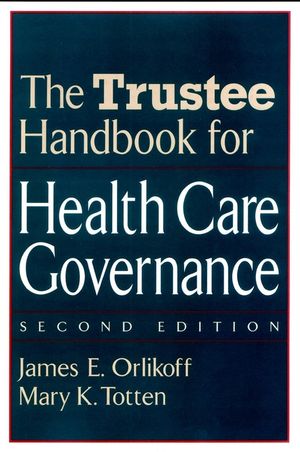The Trustee Handbook for Health Care Governance, 2nd EditionISBN: 978-0-7879-5885-5
Hardcover
336 pages
September 2001, Jossey-Bass
 |
||||||
Foreword by Connie R. Curran.
Preface.
About the Authors.
PART ONE: BOARDROOM BASICS.
1 Board Composition and Trustee Selection.
2 Board Job Descriptions.
3 Orientation: Basic Building Blocks of an Effective Board.
PART TWO: BOARD ACCOUNTABILITY.
4 Assessing and Improving Your Community's Health.
5 Board Oversight of Quality.
6 Self-Evaluation: The Mark of Good Governance.
PART THREE: STRATEGIC PLANNING AND INFORMATION.
7 Developing a Community-Focused Mission.
8 Strategic Planning by the Board.
9 Information and the Effective Board.
PART FOUR: BOARD RELATIONS.
10 CEO Evaluation and Compensation.
11 New Relationships with Physicians: An Overview forTrustees.
12 The Board-Physician Relationship: Enhancing LeadershipPotential.
PART FIVE: GOVERNANCE IN THE INTERNET AGE.
13 Stewardship in the New Age.
14 The Role of the Board in the New Health Economy.
15 Information, E-health, and the Board.
PART SIX: THE TRUSTEE AS LEADER.
16 Principle-Based Governance: An Approach to IntegratedLeadership.
17 The Role of the Board Chair.
18 The Board Leader's Role in Building and Maintaining Trust.
PART SEVEN: GOVERNANCE IN TRANSFORMATION.
19 Systems Thinking in Governance.
20 Redesigning Governance for Success.
21 Governing a Conversion Foundation: A Practical Guide forTrustees.
Part Eight: Growing the Best Board.
22 Developing the Individual Trustee.
23 Building Effective Board Committees.
24 Community Representation and the Effective Board.
References.
Index.
Preface.
About the Authors.
PART ONE: BOARDROOM BASICS.
1 Board Composition and Trustee Selection.
2 Board Job Descriptions.
3 Orientation: Basic Building Blocks of an Effective Board.
PART TWO: BOARD ACCOUNTABILITY.
4 Assessing and Improving Your Community's Health.
5 Board Oversight of Quality.
6 Self-Evaluation: The Mark of Good Governance.
PART THREE: STRATEGIC PLANNING AND INFORMATION.
7 Developing a Community-Focused Mission.
8 Strategic Planning by the Board.
9 Information and the Effective Board.
PART FOUR: BOARD RELATIONS.
10 CEO Evaluation and Compensation.
11 New Relationships with Physicians: An Overview forTrustees.
12 The Board-Physician Relationship: Enhancing LeadershipPotential.
PART FIVE: GOVERNANCE IN THE INTERNET AGE.
13 Stewardship in the New Age.
14 The Role of the Board in the New Health Economy.
15 Information, E-health, and the Board.
PART SIX: THE TRUSTEE AS LEADER.
16 Principle-Based Governance: An Approach to IntegratedLeadership.
17 The Role of the Board Chair.
18 The Board Leader's Role in Building and Maintaining Trust.
PART SEVEN: GOVERNANCE IN TRANSFORMATION.
19 Systems Thinking in Governance.
20 Redesigning Governance for Success.
21 Governing a Conversion Foundation: A Practical Guide forTrustees.
Part Eight: Growing the Best Board.
22 Developing the Individual Trustee.
23 Building Effective Board Committees.
24 Community Representation and the Effective Board.
References.
Index.



